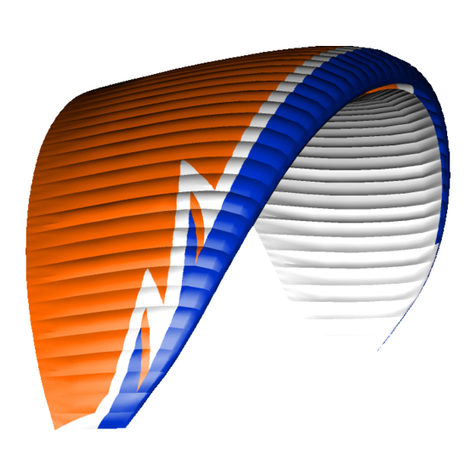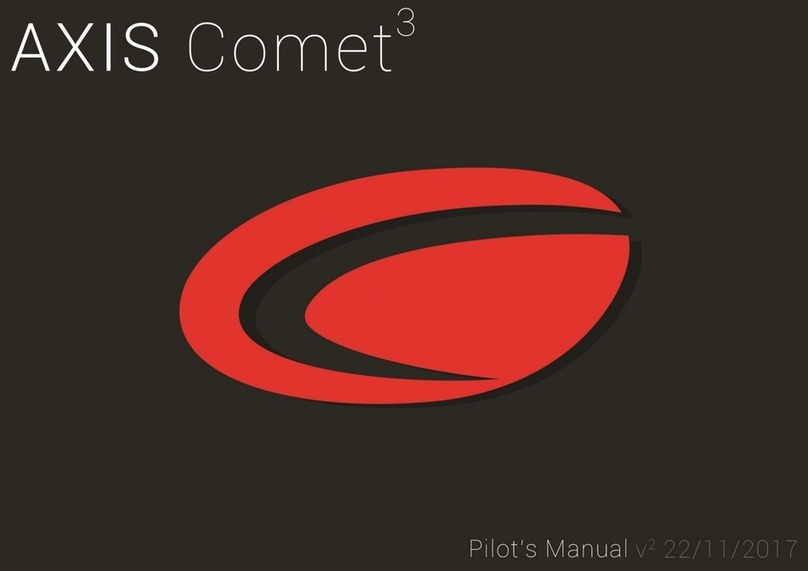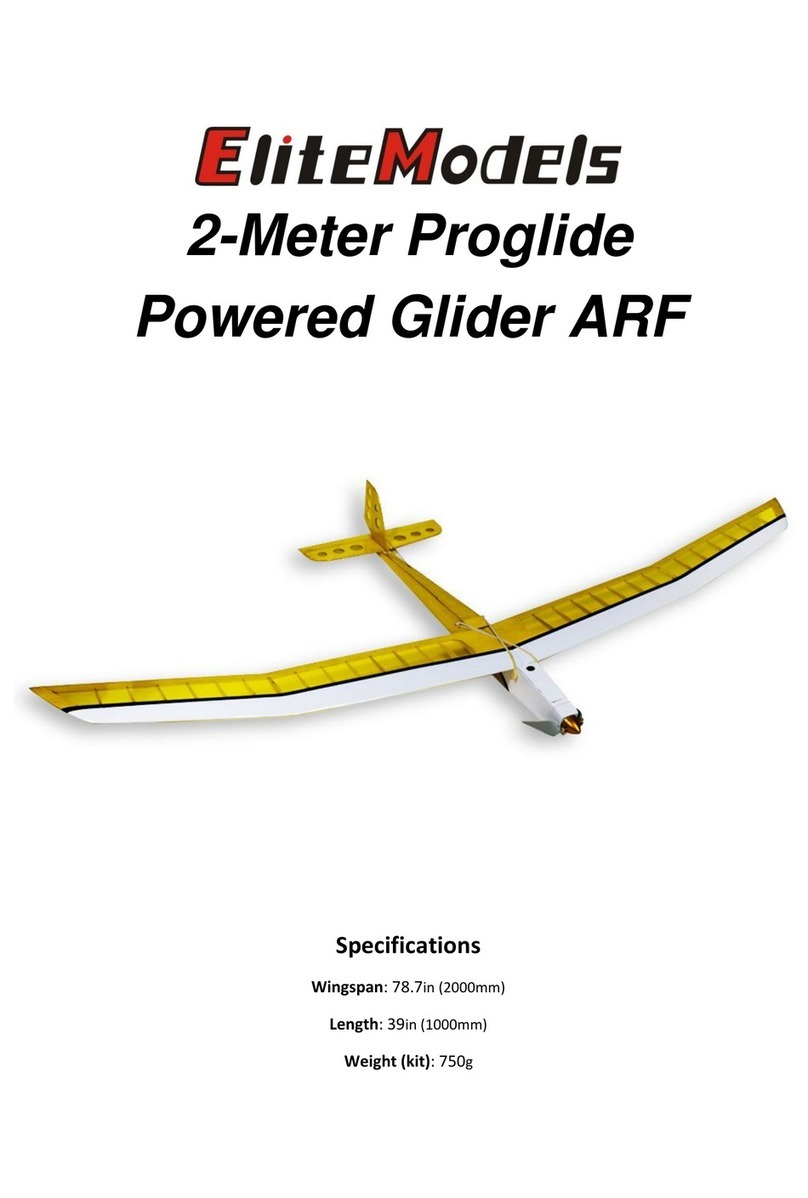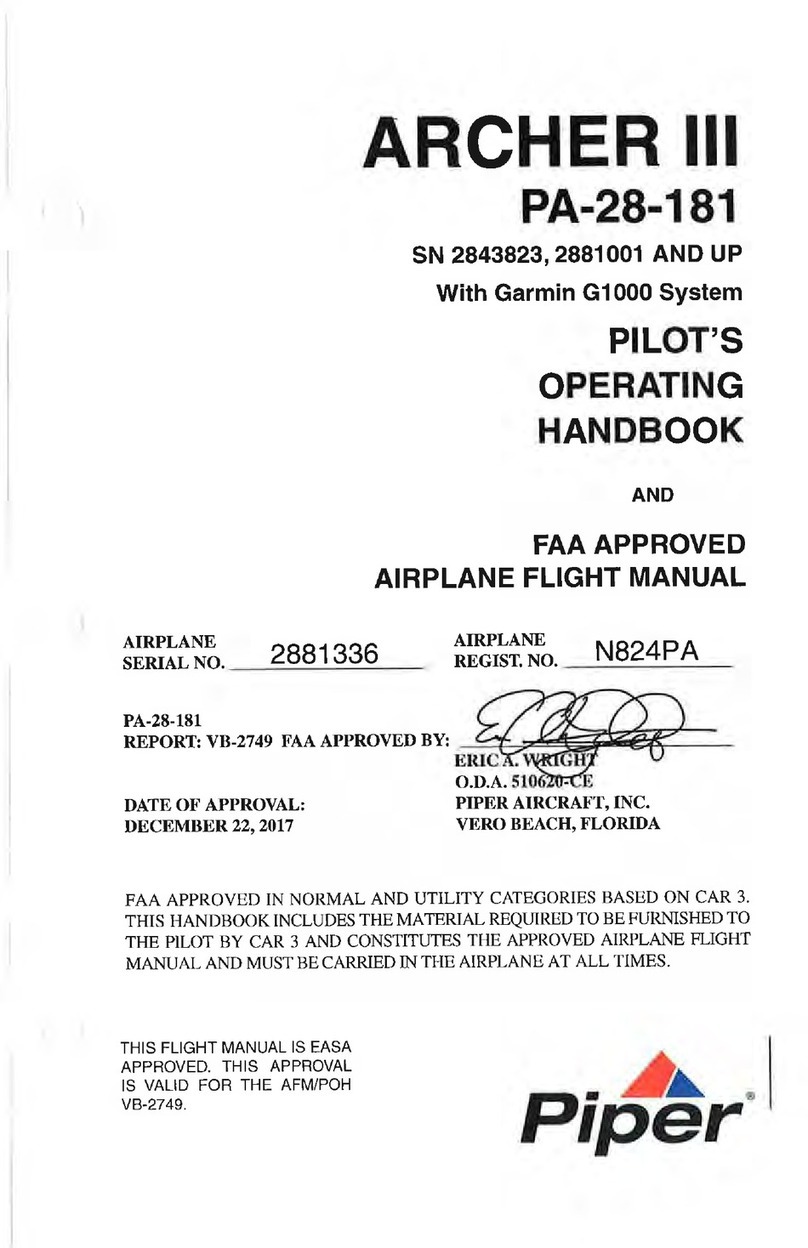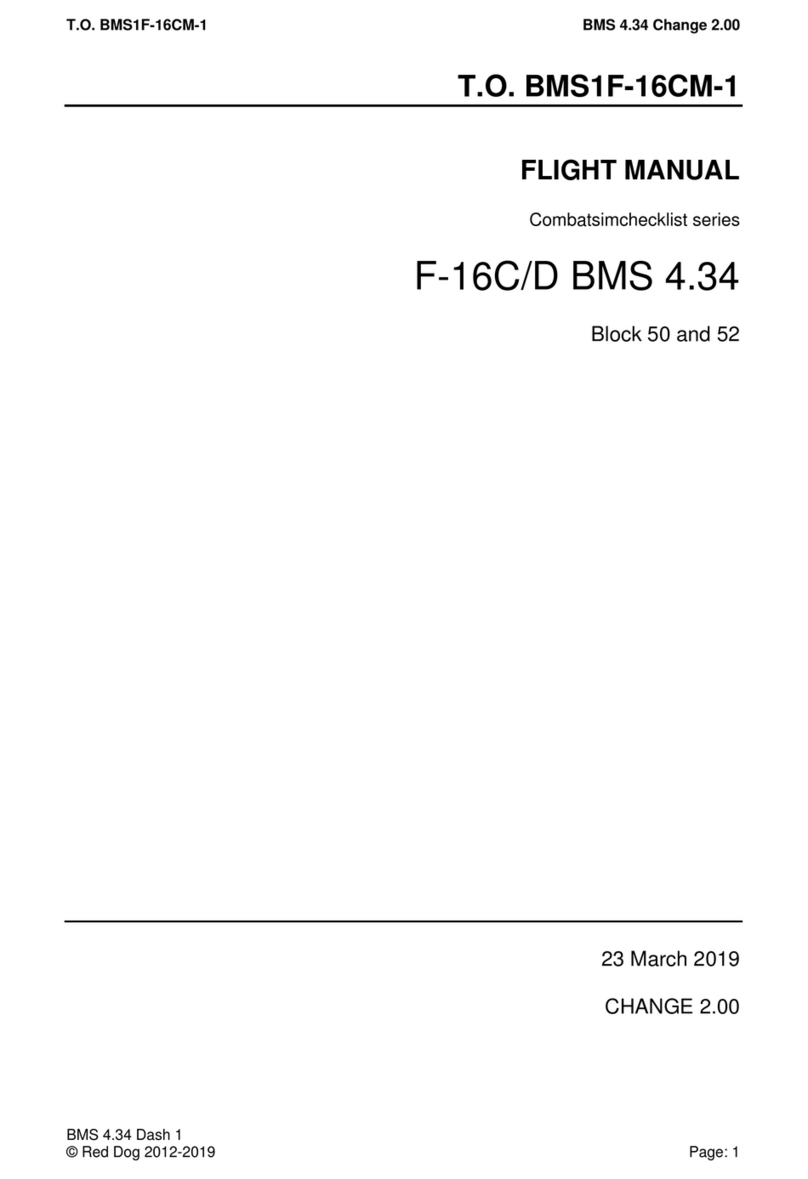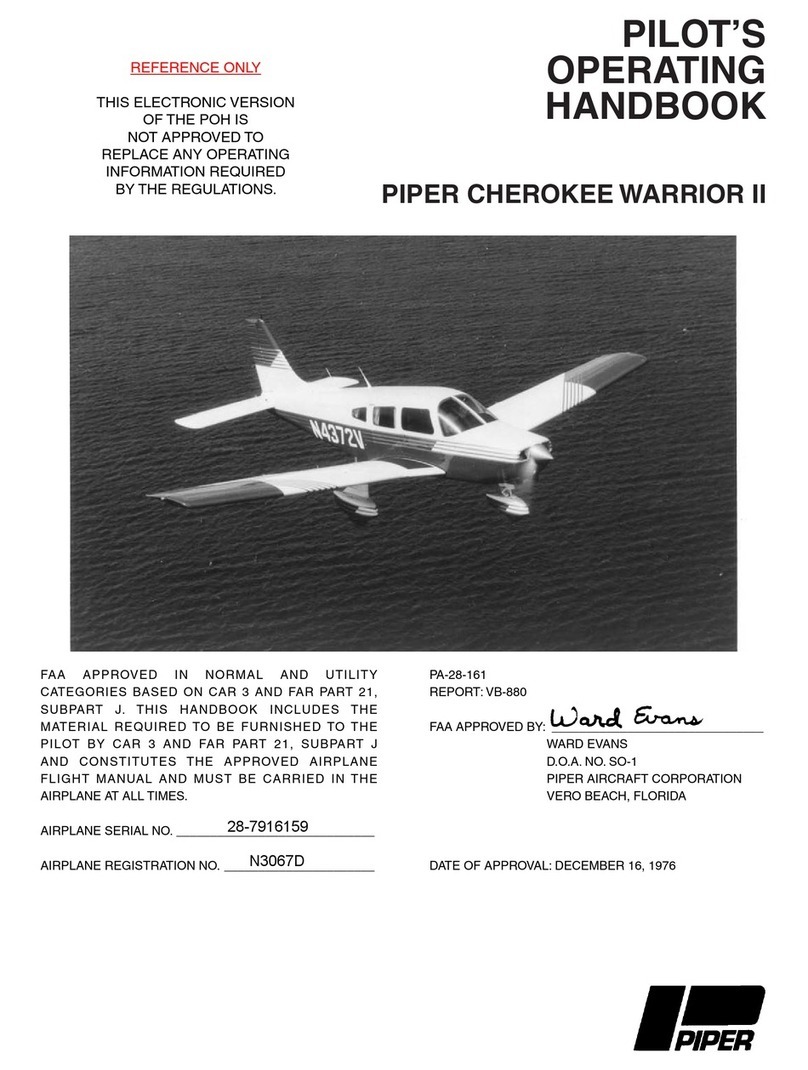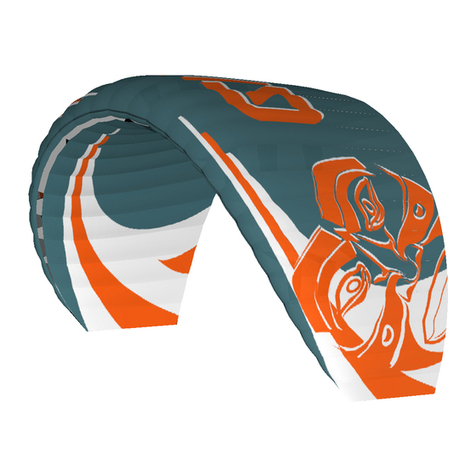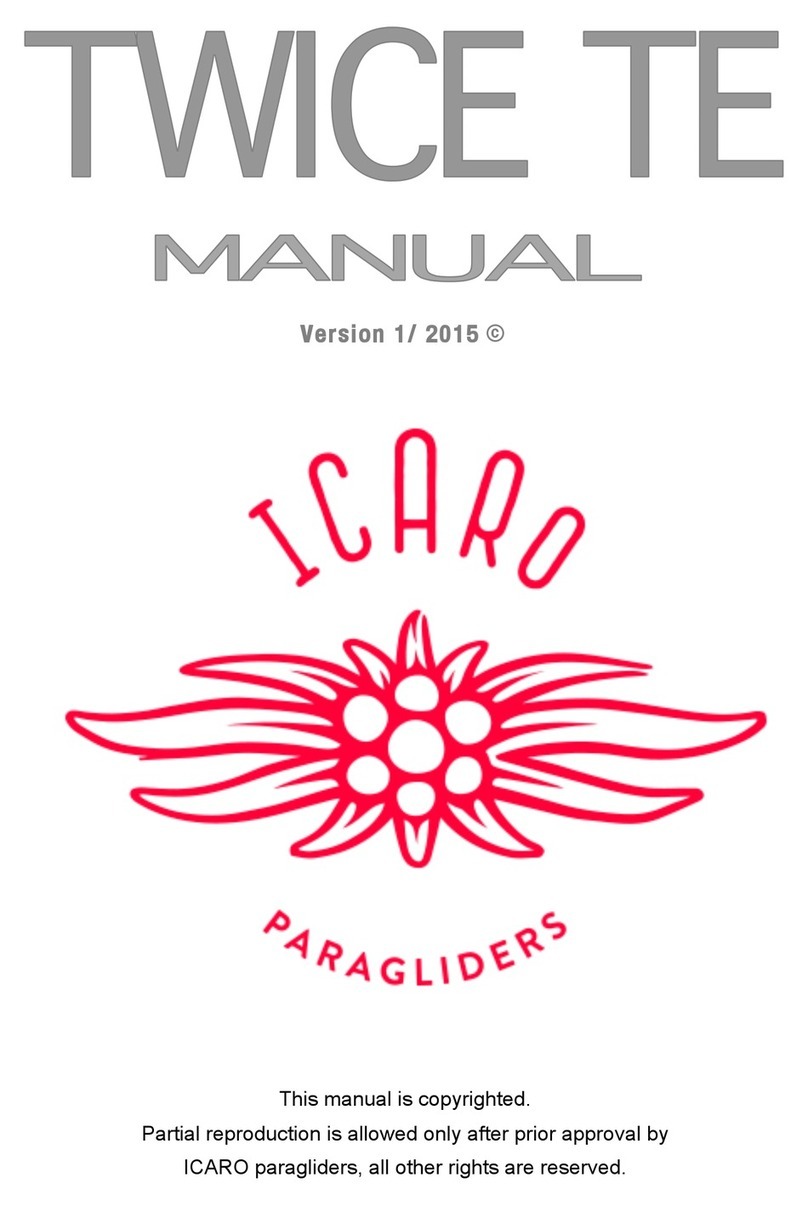B&F FK 9 Mark IV User manual

Airplane Manual
FK 9 Mark IV
Certified as Ultralight according
BFU 95 / LTF-UL 2003
Kennblatt Nr. 61102.2
This manual must be carried in the
aircraft at all times.
Serial Nr.: ____
ThisisthePilot’soperatingmanualand
approved flight manual.
Manual Nr.:
9-____-1E
Manufacturer: FK Lightplanes

Airplane Manual FK 9
B&F Technik Vertriebs GmbH
Revision 20
Section 0
page 0-1
No part of this manual may be reproduced or changed in any manner without
written agreement of the manufacturer.
Important service informations / bulletins can be obtained from our website.
Check our website regularly as automatic update by mail is not assured.
FK Lightplanes
REVISIONS
The following table contains a list of valid pages. This table will be updated
with every revision. The pilot is responsible for keeping all pages of this
manual to the revision status indicated in the table, by exchanging the
relevant pages when a new revision has been published.
For updates check the homepage of FK Lightplanes under www.fk-
lightplanes.com regularly. New revisions can be downloaded there. If you do
not have an internet connection, revisions can be ordered from FK
Lightplanes.
Revisions and Service Bulletins for the ROTAX engine are available on
www.rotax-aircraft-engines.com .

Airplane Manual FK 9
B&F Technik Vertriebs GmbH
Revision 21
Section 0
page 0-2
List of effective Pages Revision 21 Date 1. of July 2011
Page
Revision
Date
Page
Revision
Date
0-1
21
1.07.11
0-2
21
1.07.11
0-3
21
1.07.11
0-4
21
1.07.11
0-5
21
1.07.11
0-6
21
1.07.11
0-7
21
1.07.11
1-1
12
20.07.06
1-2
10
1.12.05
1-3
21
1.07.11
1-4
1
1.09.03
2-1
21
1.07.11
2-2
21
1.07.11
2-3
21
1.07.11
2-4
20
1.11.09
2-5
21
1.07.11
2-6
17
1.10.07
3-1
21
1.07.11
3-2
20
1.11.09
3-3
21
1.07.11
4-1
8
1.07.05
4-2
12
20.07.06
4-3
12
20.07.06
4-4
19
1.04.09
4-5
20
1.11.09
4-6
20
1.11.09
4-7
20
1.11.09
4-8
20
1.11.09
5-1
8
1.07.05
5-2
21
1.07.11
6-1
1
1.09.03
6-2
20
1.11.09
6-3
17
1.10.07
6-4
19
1.04.09
6-5
19
1.04.09
7-1
8
1.07.05
7-2
8
1.07.05
7-3
20
1.11.09
7-4
20
1.11.09
7-5
20
1.11.09
7-6
19
1.04.09
7-7
19
1.04.09
7-8
19
1.04.09
8-1
13
1.08.06
8-2
17
1.10.07
8-3
17
1.10.07
8-4
21
1.07.11
8-5
20
1.11.09
8-6
8
1.07.05
8-7
8
1.07.05
9-1
15
1.03.07

Airplane Manual FK 9
B&F Technik Vertriebs GmbH
Revision 21
Section 0
page 0-3
TABLE OF CONTENTS
1. GENERAL ................................................................................. 1-1
1.1. Airplane Three Side View........................................... 1-2
1.2. Technical Data ............................................................ 1-3
1.3. Abbreviations and Terminology................................ 1-3
2. LIMITATIONS............................................................................ 2-1
2.1. General ........................................................................ 2-1
2.2. Airspeed Limitations .................................................. 2-1
2.3. Airspeed Indicator Markings ..................................... 2-2
2.4. Power Plant Limitations............................................. 2-2
2.5. Propeller ...................................................................... 2-3
2.6. Weights........................................................................ 2-4
2.7. C.G. Limits................................................................... 2-4
2.8. Maneuvers ................................................................... 2-4
2.9. Flight Load Factors .................................................... 2-5
2.10. Kind of Operation ....................................................... 2-5
2.11. Fuel / Oil / Coolant ...................................................... 2-5
2.12. Passenger Seating ..................................................... 2-5
2.13. Colour .......................................................................... 2-6
2.14. Electric......................................................................... 2-6

Airplane Manual FK 9
B&F Technik Vertriebs GmbH
Revision 21
Section 0
page 0-4
2.15. Placards....................................................................... 2-6
3. EMERGENCY PROCEDURES ................................................. 3-1
3.1. General ........................................................................ 3-1
3.2. Engine Failure ............................................................. 3-1
3.3. Fuel Pressure Low...................................................... 3-1
3.4. Generator Fault ........................................................... 3-1
3.5. Glide............................................................................. 3-1
3.6. Emergency Landing ................................................... 3-2
3.7. Strong Vibrations ....................................................... 3-2
3.8. Steering Problems ...................................................... 3-2
3.9. Fire and Smoke ........................................................... 3-3
3.10. Stall recovery .............................................................. 3-3
4. NORMAL PROCEDURES ........................................................ 4-1
4.1. General ........................................................................ 4-1
4.2. Regular Inspection ..................................................... 4-1
4.3. Preflight Inspection .................................................... 4-1
4.4. Engine Start................................................................. 4-4
4.5. Taxi............................................................................... 4-4
4.6. Before Take-off ........................................................... 4-5
4.7. Takeoff ......................................................................... 4-5
4.8. Climb............................................................................ 4-6

Airplane Manual FK 9
B&F Technik Vertriebs GmbH
Revision 21
Section 0
page 0-5
4.9. Cruise........................................................................... 4-6
4.10. Descent........................................................................ 4-6
4.11. Landing........................................................................ 4-7
4.12. Touch and Go.............................................................. 4-8
4.13. After Landing / Parking .............................................. 4-8
5. PERFORMANCE ...................................................................... 5-1
5.1. General ........................................................................ 5-1
5.2. Takeoff Distance......................................................... 5-1
5.3. Cruise Performance ................................................... 5-2
5.4. Service Ceiling ............................................................ 5-2
6. WEIGHT AND BALANCE......................................................... 6-1
6.1. General ........................................................................ 6-1
6.2. Basic Empty Weight ................................................... 6-1
6.3. Determination of C.G. for the Flight ......................... 6-3
7. SYSTEMS DESCRIPTION........................................................ 7-1
7.1. General ........................................................................ 7-1
7.2. Instrument Panel ........................................................ 7-1
7.3. Rescue system ........................................................... 7-2
7.4. Flaps ............................................................................ 7-3
7.5. Tyres ............................................................................ 7-3

Airplane Manual FK 9
B&F Technik Vertriebs GmbH
Revision 21
Section 0
page 0-6
7.6. Baggage....................................................................... 7-4
7.7. Seats and seatbelts .................................................... 7-4
7.8. Doors ........................................................................... 7-4
7.9. Engine.......................................................................... 7-4
7.10. Fuel System................................................................. 7-5
7.11. Brakes.......................................................................... 7-7
7.12. Heating and Ventilation.............................................. 7-7
7.13. Electrical System ........................................................ 7-7
8. HANDLING, SERVICING AND MAINTENANCE ..................... 8-1
8.1. General ........................................................................ 8-1
8.2. Ground Handling ........................................................ 8-1
8.3. Cleaning....................................................................... 8-1
8.4. General Advice ........................................................... 8-1
8.5. Regular Maintenance and Lubrication Schedule .... 8-2
8.6. Time between Overhaul (TBO) .................................. 8-2
8.7. Fuel System Check / Cleaning .................................. 8-4
8.8. Control Surface Angle................................................ 8-4
8.9. Jacking / Towing / Storage ........................................ 8-4
8.10. Main / Subsidiary Structure ....................................... 8-5
8.11. Materials for minor repairs ........................................ 8-5
8.12. Special Repair and Check Procedures..................... 8-5

Airplane Manual FK 9
B&F Technik Vertriebs GmbH
Revision 21
Section 0
page 0-7
8.13. Required Tools ........................................................... 8-5
8.14. Weighing...................................................................... 8-5
8.15. Mounting / Maintenance of the Rescue System ...... 8-6
8.16. Assembly of the Aircraft ............................................ 8-6
9. SUPPLEMENTS........................................................................ 9-1
9.1. General ........................................................................ 9-1
9.2. Engine Manual ............................................................ 9-1
9.3. Rescue System ........................................................... 9-1
9.4. Avionics / Special Engine Instruments .................... 9-1
9.5. Kremen Propeller........................................................ 9-1
9.6. Sailplane Towing ........................................................ 9-1
9.6.1. Technical Data / Limitations .................................. 9-1

Airplane Manual FK 9
B&F Technik Vertriebs GmbH
Revision 17
General
page 1-1
1. General
This manual must be read carefully by the owner and operator in order to
become familiar with the operation of the FK 9. The manual presents
suggestions and recommendations to help obtain safe and maximum
performance without sacrificing economy.
The owner and operator should also be familiar with the applicable aviation
regulations concerning operation and maintenance of this airplane.
All limits, procedures, safety practices, servicing, and maintenance
requirements contained in this manual are considered mandatory for the
continued airworthiness of the airplane.
All values in this manual are based on ICAO Standard Atmosphere
conditions and maximum takeoff weight (MTOW).
The pilot in command has to make sure that the airplane is airworthy and
operated according to this manual.
Non-compliance with handling, maintenance and checking instructions as
indicated in the flight and maintenance manuals as well as the respective
updates which are published in the manufacturer’s website, will void
warranty and/or guarantee claims.
This manual applies to both versions, FK 9 Mark 4 and FK 9 Mark 4 Utility.
The difference between both versions liesinwingconstruction.The“Utility”
is ceconite-covered in the aft wing section unlike the composite cover of the
basic Mark 4.
The FK 9 SW (shortwing) is a variant with less wingspan.
All variants of airframes and powerplants can be combined as certified.

Airplane Manual FK 9
B&F Technik Vertriebs GmbH
Revision 10
General
page 1-2
1.1. Airplane Three Side View

Airplane Manual FK 9
B&F Technik Vertriebs GmbH
Revision 21
General
page 1-3
1.2. Technical Data
normal
shortwing
Wing span:
9,85 m
9,25 m
Length:
5,94 m
Wing area:
11,42 qm
10,73 qm
Height:
2,43 m
1.3. Abbreviations and Terminology
a) Speeds
IAS
Indicated airspeed = speed as shown on the airspeed indicator
CAS
Calibrated Airspeed is the indicated airspeed, corrected for position
and instrument error. CAS is equal to TAS in standard atmosphere
at sea level
TAS
True airspeed = speed relative to undisturbed air
VA
Maneuvering speed = max. speed at which application of full
available aerodynamic control will not overstress the airplane
VRA
Maximum speed in turbulence
VNE
Never exceed speed is the speed limit that must not be exceeded
at any time
VNO
Maximum structural cruising speed is the speed that should not be
exceeded except in smooth air and only with caution
VS
Stalling speed or the minimum steady flight speed at which the
airplane is controllable
VSO
Stalling speed in landing configuration (full flaps)
VX
Best angle of climb speed which delivers the greatest gain of
altitude in the shortest possible horizontal distance
VY
Best rate of climb speed which delivers the greatest gain of altitude
in the shortest possible time
b) Meteorological
ISA
International Standard Atmosphere: OAT in MSL 15°C; pressure in
MSL 1013,2hPa; air a perfect dry gas; temperature gradient of
0,65°C per 100m
MSL
Mean sea level
OAT
Outside air temperature

Airplane Manual FK 9
B&F Technik Vertriebs GmbH
Revision 1
General
page 1-4
c) Weight and Balance
Reference
Datum
An imaginary vertical plane from which all horizontal
distances are measured for balance purposes
Arm
The horizontal distance from the reference datum to the
center of gravity of an item
Moment
The product of the weight of an item multiplied by its arm
Airplane center
of gravity (C.G.)
The point at which an airplane would balance if sus-
pended. Its distance from the reference datum is found by
dividing the total moment by the total weight of the
airplane
C.G. arm
Thearmobtainedbyaddingtheairplane’sindividual
moments and dividing the sum by the total weight
C.G. limits
The extreme center of gravity locations within which the
airplane must be operated at a given weight
Empty weight
Weight of the airplane including unuseable fuel, full
operating fluids and full oil; equipment as indicated

Airplane Manual FK 9
B&F Technik Vertriebs GmbH
Revision 8
Limitations
page 2-1
2. Limitations
2.1. General
This chapter contains limitations, instrument markings and placards required
for the safe operation of the aircraft.
Limitations valid for additional equipment can be found in chapter 9
(supplements).
2.2. Airspeed Limitations
The airspeed limitations for both versions except VNE are identical. This
table shows stall speed VSand maximum speed VFE for the respective flap
setting (based on a weight of 472,5 kg):
Flap pos.
VS
VFE
Remark
2
65 km/h
105 km/h
short field landing
1
70 km/h
117 km/h
takeoff / normal landing
0
75 km/h
Utility
230 km/h
215 km/h
cruise
never exceed speed
VNE :
230 km/h
Version Utility (or with Junkers Rescue System)
VNE :
215 km/h
max. speed in turbulence
VRA :
184 km/h
maneuvering speed
VA:
151 km/h
best angle of climb (flaps pos. 1)
VX:
95 km/h
best rate of climb (flaps up)
VY:
110 km/h
maximum crosswind component
CWC:
27 km/h
with door(s) removed
100 km/h

Airplane Manual FK 9
B&F Technik Vertriebs GmbH
Revision 21
Limitations
page 2-2
2.3. Airspeed Indicator Markings
Every aircraft must be equipped with an airspeed indicator type “WinterFK9
Mk3/Mk4”, which is calibrated to the aircraft. This is the master airspeed
indicator, even with an EFIS installed.
The airspeed indicator has following markings and shows IAS in [km/h]:
white arc
1,1*VSO to VFE
72 to 105 km/h
full flap operating range
(flaps in pos. 2)
green arc
1,1*VS1 to VRA
83 to 184 km/h
normal operating range
(flaps in pos. 0)
yellow radial
at VA 151 km/h
maneuvering speed
yellow arc
VRA to VNE
184 to 230 km/h
Utility or Junkers
Rescue System
215 km/h
operate with caution,
only in smooth air
red radial
at VNE 230 km/h
Utility 215 km/h
max. speed for all operations
2.4. Power Plant Limitations
This is summary of the respective (ROTAX or M160) engine manual. In case
of any discrepancy the engine manual shall apply.
M160 (SMART)
60 KW
74 KW
Oil
automobile - oil (API SG)
Oil capacity
3,2 l; difference MAX - MIN 0,5 l
Note: never fill up above MAX
Oil temperature
min 50°C, max. 140°C normal 100 - 130°C
Oil pressure
1,5 bar to 4,5 bar
Fuel
Unleaded car fuel without bioethanol (min 95 ROZ)
Manifold press
1,9 (+0,1/-0,2) bar
2,3 (+0,1/-0,1) bar
Water temp.
normal 90°C; maximum 105°C

Airplane Manual FK 9
B&F Technik Vertriebs GmbH
Revision 21
Limitations
page 2-3
ROTAX 912 UL
ROTAX 912 ULS
Oil
automobile - oil (API SF or SG)
Oil capacity
2,6 Ltr (min) to 3,05 Ltr (max)
Oil temperature
min 50°C, max. 140°C
min 50°C, max. 130°C
Oil pressure
1,5 bar to 5 bar (engine start 7 bar)
Fuel
car fuel without bioethanol (min 95 ROZ)
MOGAS, AVGAS 100LL
Fuel pressure
0,15 bar to 0,4 bar
CHT
max. 120°C
when using water / glycol mixture
Magneto check
min. 2800 U/min
Max. drop
300 U/min
Note: Subject: Oil system, Engine lubrication system
Engines which have had the prop spun for more than 1 turn in reverse
direction allow air to be injested into the valve train.
Action:
1. It is forbidden to spun the prop in reverse direction for more than 1
turn.
2. Inspection for correct venting of the oil system has to be performed
in cases when the prop has been spun in reverse direction for more
than 1 turn.
2.5. Propeller
Pos.
Engine
Propeller
Diameter
01
ROTAX 912 UL
Junkers PR-170-3R
1700 mm
02
ROTAX 912 UL
Warp / DUC 3 –blade
1720 mm
03
ROTAX 912 UL
Kremen SR 2000 (adjustablel)
1700 mm
04
ROTAX 912 ULS
Sport Prop Klassik 3 blade
1710 mm
05
ROTAX 912 ULS
Warp / DUC 3 –blade
1720 mm
06
M 160 (60 KW)
Warp / DUC 3 - blade
1720 mm
07
M 160 (74 KW)
Warp / DUC 3 - blade
1720 mm
08
ROTAX 912 ULS
DUC FC 3 - Blatt
1727 mm

Airplane Manual FK 9
B&F Technik Vertriebs GmbH
Revision 20
Limitations
page 2-4
2.6. Weights
Maximum weight per seat:
100 kg
Baggage aft max:
10 kg
Total of fuel + baggage max.:
46,5 kg
Empty weight:
acc. actual weighing
Maximum Takeoff Weight:
472,5 kg
if certified acc.
LTF-UL 2003
Maximum Landing Weight
472,5 kg
2.7. C.G. Limits
forward center of gravity:
0,22m behind datum
aft center of gravity
0,44m behind datum
Datum is the leading edge of the wing.
2.8. Maneuvers
The FK 9 is certified as an Ultralight aircraft.
Acrobatic maneuvers, including spins, bank angles greater than 60°, as well
as IFR and VFR night are prohibited.
Note regarding spins: In the light aircraft/ultralight category spinning is
strictly prohibited and is not required to demonstrate during flight test
program.
Despite this, all FK aircraft have also been tested regarding their general
spin characteristics. In general it is important to know that a spin is a very
complex flight condition and relates to many individual factors like weight,
centre of gravity, mass distribution, aerodynamic conditions, number of spin
turns already performed, kind of control deflections already made and so on.
For example, the spinning characteristic of the same aircraft on the same
day can differ significantly because of differences in mass distribution or dirt
onsurfaces.Thiscancausea“nonrecoverable”spin-condition!
In practice this means that flying into stalls on purpose must be avoided and
recovery procedures have to be performed immediately!

Airplane Manual FK 9
B&F Technik Vertriebs GmbH
Revision 21
Limitations
page 2-5
Spinning any aircraft which is not certified for this maneuver is extremely
dangerous! The onset of a stall is indicated to the pilot by many factors like
IAS, stick pressure, horizon level. Stalls can also be result from abrupt
control deflections / changes in angle of attack!
In strong turbulence the airspeed must be reduced below VA(151 km/h).
When flying off grass strips with long grass, the wheel pants must be
removed to avoid damage.
When flying with doors removed, maximum speed is 100 km/h. Flight with
door open is prohibited.
Maneuvers with zero or negative load factors must be avoided under all
conditions. These maneuvers may cause a fire due to fuel spill when using
ROTAX engines with carburetors.
2.9. Flight Load Factors
positive
negative
Maximum load factor at VA
+ 4g
- 2g
Maximum load factor at VNE
+ 4g
- 1,5g
Maximum load factor with flaps down
+ 2g
0g
2.10. Kind of Operation
The FK 9 is approved as Ultralight aircraft for VFR day (Nfl 1-96/82).
2.11. Fuel / Oil / Coolant
Engine operating manual is the governing one!
Tank
Capacity 60 Ltr; 1 Ltr not useable
Fuel
Compare engine limitations
Unleaded fuel without bioethanol recommended, mandatory
for M160 (smart)
AVGAS should only be used if MOGAS is not available or in
case of problems caused by vapour locks
Oil
Compare engine limitations
synthetic oils preferred; do not use aircraft oil !
Oil capacity
Compare engine limitations
Coolant
Compare engine limitations
2.12. Passenger Seating
The aircraft has 2 seats. It can be flown from either seat.

Airplane Manual FK 9
B&F Technik Vertriebs GmbH
Revision 17
Limitations
page 2-6
2.13. Colour
The surface of the structure (composite structure) must be white or yellow.
Local coloured decoration is possible. Complete painting in different colours
only with agreement of the manufacturer.
2.14. Electric
The electrical system is designed for a maximum load of 12 A.
2.15. Placards
Location:
Placard:
In the Cockpit
max. TOW 472,5 kg
spins and acrobatics prohibited
Cockpit
Weighing date:
Empty weight:
Poss. load including fuel:
Cockpit rear section
Type placard (metal)
Door handles (inside + outside)
OPEN / CLOSE
Fuel selector in flow direction
fuel
Fuel selector closed position
close
Aft baggage compartment
max. load 3 kg with 60L fuel
Choke (ROTAX only)
choke
Carburetor heat
carb. (option)
Cabin heat
cabin heat (option)
Throttle friction
throttle friction
Trim handle
trim
Trim markings
Neutral; nose up; nose down
Park brake valve
Park
Brake handle
Brake
Flap indication
“110”/“95”closetoindicationLED
Oil temperature indication VDO
OIL
CHT indication VDO
CHT
Fuel cap
FUEL AVGAS / MOGAS
Fuel indication
markings every 10l + tank full
Vicinity of rescue system
placard Rescue system
Rocket Exit Area
Danger: Rocket Exit Area
Safety pin rescue system
Remove before flight
Top of vertical fin
Company logo
Wing tip (ext. wing connection mechanism installed)
OPEN / CLOSE
Wheel fairings main wheels
2,0 bar
Wheel fairing nose wheel
1,5 bar
Towing version only:
Vicinity of airspeed indicator
Care for tow speed !
Handle for cowlflap
Cowlflap
Towing clutch
max. break load 200kp
Handle for towing clutch
TOW

Airplane Manual FK 9
B&F Technik Vertriebs GmbH
Revision 21
Emergency Procedures
page 3-1
3. Emergency Procedures
3.1. General
The following information is presented to enable the pilot to form, in
advance, a definite plan of action for coping with the most probable
emergency situations which could occur in the operation of the airplane.
3.2. Engine Failure
Glide speed
100 km/h flaps pos. 1
Electrical fuel pump
ON (ROTAX only)
Fuel selector
check ON
Fuel remaining
check
Ignition (SMART only)
OFF then ON (electronic reset)
Engine
start
No restart possible:
Emergency landing
perform respective procedure
3.3. Fuel Pressure Low
In the event of a fuel pressure low indication, switch ON the electrical fuel
pump (ROTAX only).
3.4. Generator Fault
In the event of a power generator fault, switch OFF all non-essential devices
in order to save battery power.
With Smart engine installed, land immediately as the engine ignition is
powered by battery. The engine will stop as soon as the battery charge is
exhausted. Depending on the rating and charge status of the built-in battery
as well as engine RPM, this might happen after 5 to 8 minutes.
3.5. Glide
Glide ratio is about 1:13 for best glide speed 100 km/h (flaps pos. 1).

Airplane Manual FK 9
B&F Technik Vertriebs GmbH
Revision 20
Emergency Procedures
page 3-2
3.6. Emergency Landing
Glide speed
100 km/h flaps pos. 1
Emergency field
select
Emergency call (121,5 MHz)
perform
Throttle
close
Electrical fuel pump
OFF (ROTAX only)
Fuel selector
OFF (ROTAX only)
Ignition / Battery switch
OFF
Safety belts
pull tight
Final, landing assured:
Flaps
full down
Approach speed
90 km/h
The glide can be controlled by changing airspeed, flap setting or slip. Use
caution, flaps in position 2 cause a lot of drag. Airspeed indication remains
valid during slip. Touchdown should be achieved at minimum speed.
3.7. Strong Vibrations
Caused by engine or propeller:
Ignition
OFF
Airspeed
reduce
Emergency landing
perform respective Abnormal List
Caused by the fuselage / wings:
Airspeed
reduce
3.8. Steering Problems
Aircraft uncontrollable with remaining flight controls:
Throttle
close
Ignition
OFF
Rescue system
activate
Electrical fuel pump
OFF (ROTAX only)
Fuel selector
OFF (ROTAX only)
Emergency call (121,5 MHz)
perform
Battery switch
OFF
Safety belts
pull tight
Doors
unlatch
Popular Aircraft manuals by other brands

Beechcraft
Beechcraft Bonanza V35B Pilot operating handbook
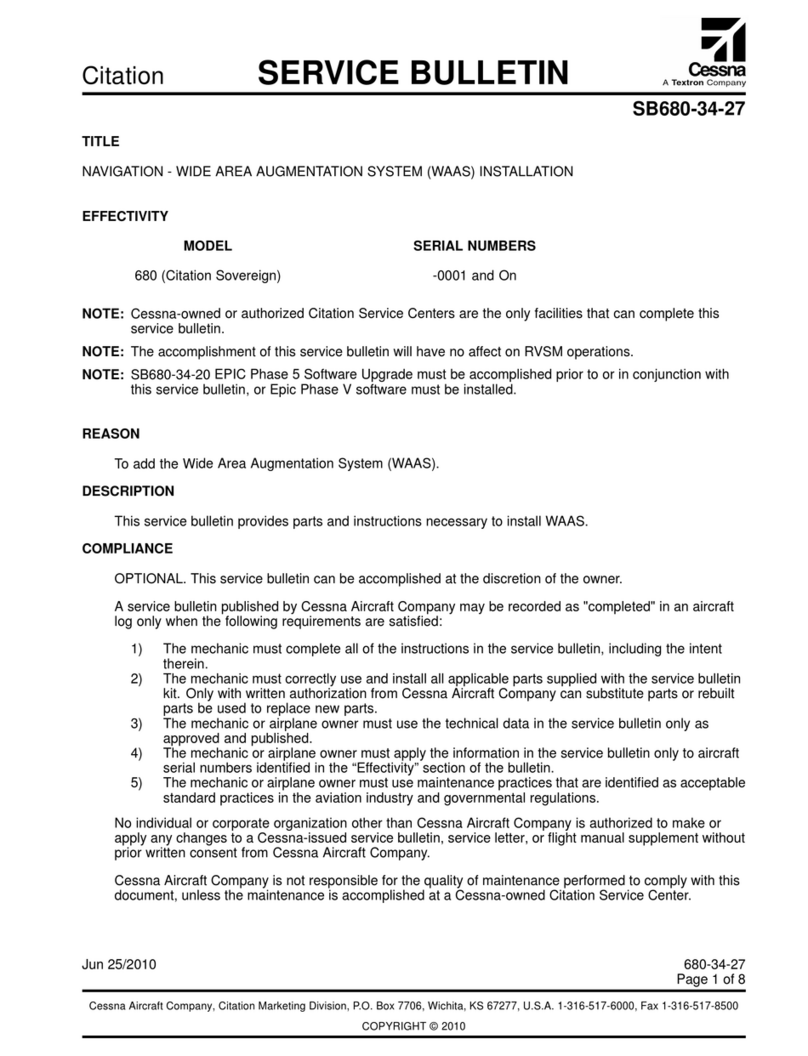
Textron
Textron Cessna 680 Citation Sovereign Service bulletin
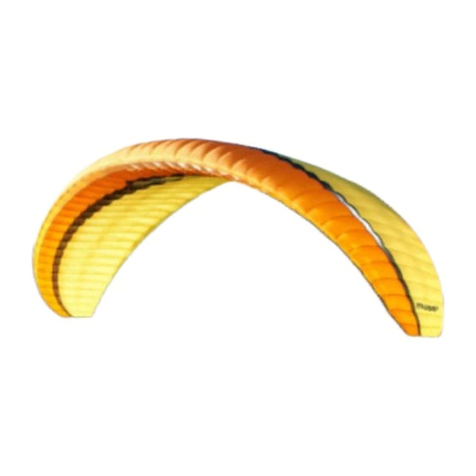
MAC PARA
MAC PARA Muse 3 user manual
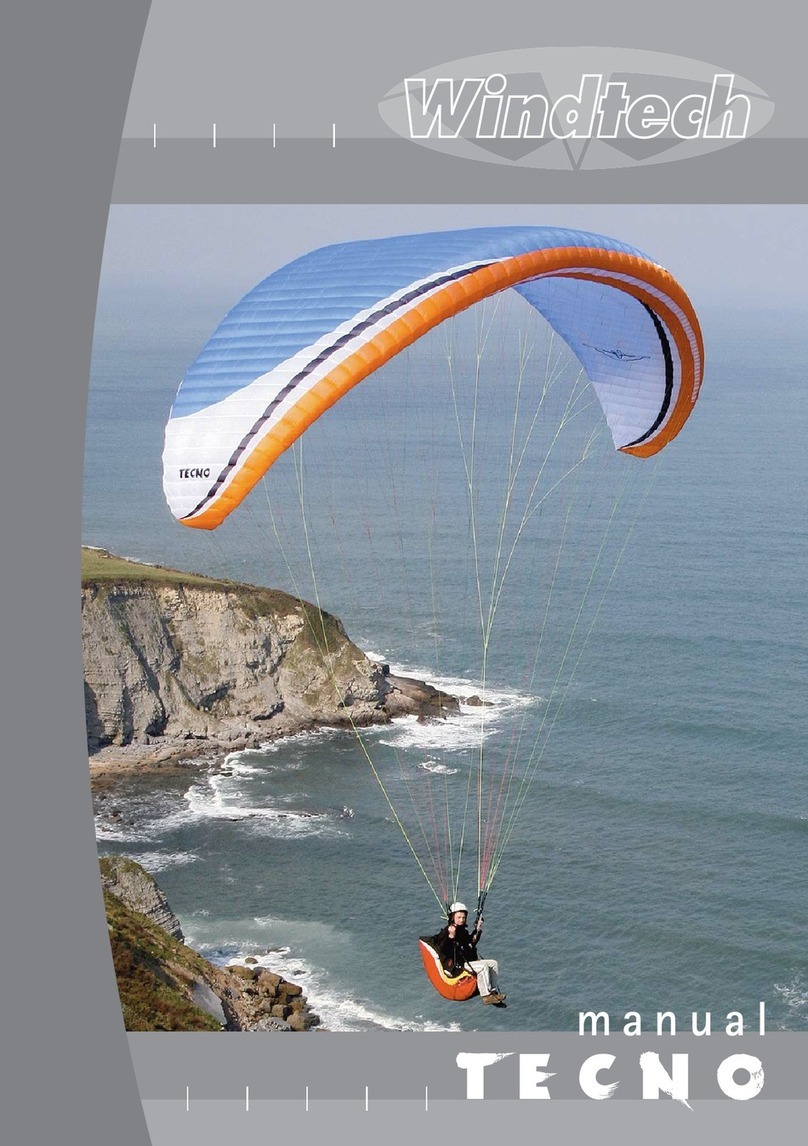
WINDTECH
WINDTECH Tecno Series Flight manual

Mooney
Mooney M20L Service and maintenance manual

Piper
Piper SARATOGA II HP PA-32R-301 Pilot operating handbook


